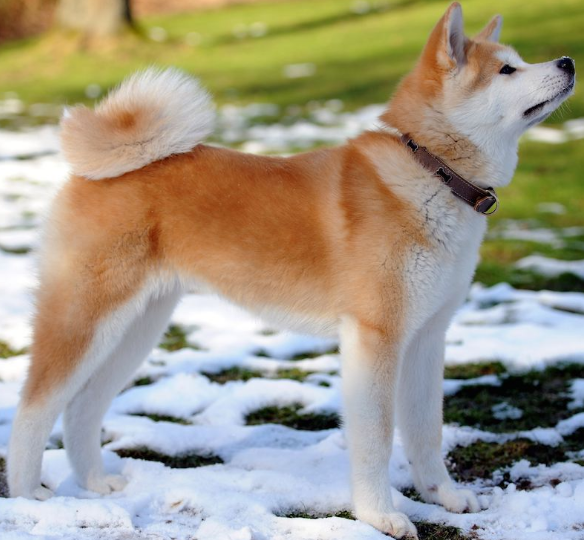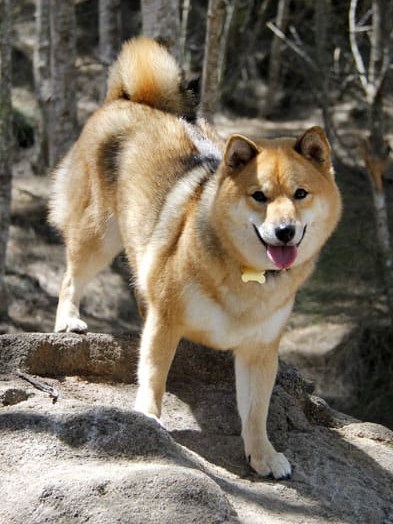Description Of Akita

The Akita is a large breed of dog whose origin is believed to be the mountainous regions of northern Japan. The Akita is an independent and dominant breed with a short double-coat similar to that of German shepherd. Any Akita breed does not designate any specific markings or patterns and thus many Akitas have facial masks or white blazes on the forehead. Sometimes the outer-coat is different from the undercoat.
There are two separate varieties of Akita that is, a Japanese strain commonly referred to as Akita Inu or Japanese Akita and the American Akita commonly referred to as American Akita. The American Akita comes in all dog colors whereas the Japanese Akita comes in a narrow shade of colors.
Akita is not naturally friendly towards a cat, child, strangers and other dogs. As a general precaution, the breed requires to be supervised around children and other pets. More importantly, Akitas are prone to conditions like Hip Dysplasia, Eye Diseases, obesity, vision loss and hyperthyroidism.
Description of Shiba Inu

Shiba Inu is a small agile dog whose origin is Chuba region of Japan. Originally, Shiba inu was bred to hunt and flush small game, such as birds and rabbit. This dog breed is similar to and often confused for other Japanese breeds like the Akita Inu or Hokkaido. The Shiba Inu is double coated, with the outer coat being stiff and straight and the undercoat is soft and thick. Shiba Inu has a fox-like facial composition and almond eyes. It is also muscular and has a more defined tuck up at the abdominal area, giving it a slimmer appearance.
The average life expectancy of shiba inu is between 13 and 16 years. Shiba Inu is most often considered to be less healthy breed than Akita. Shiba Inu are prone to conditions like Hip Dysplasia, Eye Diseases, allergies, skin irritation, skin diseases and hyperthyroidism. Usually, periodic joint examinations are recommended throughout the dog’s life. Eye tests should be performed yearly as eye problem can develop over time. It is also important to note that, as is with most dog breeds, Shibas should be walked or otherwise exercised daily.
Features Of Akita
- Akita is among the largest Japanese dog breeds, weighing between 70-130 pounds and standing between 24-48 inches tall.
- Any Akita breed does not designate any specific markings or patterns and thus many Akitas have facial masks or white blazes on the forehead. Sometimes the outer-coat is different from the undercoat.
- The Akita has broad head and small deep-set eyes with a stocky muscular appearance.
- Akita is not naturally friendly towards a cat, child, strangers and other dogs. As a general precaution, the breed requires to be supervised around children and other pets.
- With proper care, the life expectancy of Akita can be between 13 and 16 years.
- Akita tends to drool a lot.
- Akita is most often considered to be healthier breed than Shiba Inu. Akitas are prone to conditions like Hip Dysplasia, Eye Diseases, obesity, vision loss and hyperthyroidism.
- Akita tends to be less playful when compared with Shiba Inu.
- Akitas due to body size, they require more food which means the cost of domestication is high.
- Requires extremely high level of exercise, at least 120 minutes per week.
- Less aggressive type of breed.
- Unpleasant behavior of Akita Include: Jumping, Chewing and Barking.
Features Of Shiba Inu
- Shiba Inu is among the smallest Japanese dog breeds, standing between 13.5-16.5 inches tall and weighing anywhere between 17-23 pounds.
- Shiba Inu found in only brindle, white and red. Regardless of color, Shiba Inu must have light cream or white undersides, starting underneath the chin all the way to the underside of the tail.
- Shiba Inu has a fox-like facial composition and almond eyes. It is also muscular and has a more defined tuck up at the abdominal area, giving it a slimmer appearance.
- Shiba Inu is loyal and protective, but its aloofness with strangers can sometimes become troublesome. However, it does get along with other dogs of opposite sex.
- The Average life expectancy of Shiba Inu is longer compared to Akita Inu. Akita can live anywhere between 13 and 16 years.
- Shiba Inu does not drool.
- Shiba Inu is most often considered to be less healthier breed than Akita. Shiba Inu are prone to conditions like Hip Dysplasia, Eye Diseases, allergies, skin irritation, skin diseases and hyperthyroidism.
- Due to their small body size, Shiba Inu tends to be more playful than Akita.
- Shiba Inu due to small body size, they require less food and therefore the cost of domestication is less when compared to that of Akita.
- Requires relatively high level of exercise, at least 90 minutes per week.
- More aggressive type of breed.
- Unpleasant behavior include: Chewing and Digging.
Also Read: Difference Between German Shepherd And Labrador Retriever
Comparison Between Akita And Shiba Inu In Tabular
| BASIS OF COMPARISON | AKITA | SHIBA INU |
| Size | Akita is among the largest Japanese dog breeds, weighing between 70-130 pounds and standing between 24-48 inches tall. | Shiba Inu is among the smallest Japanese dog breeds, standing between 13.5-16.5 inches tall and weighing anywhere between 17-23 pounds. |
| Shape | It has broad head and small deep-set eyes with a stocky muscular appearance. | It has a fox-like facial composition and almond eyes. It is also muscular and has a more defined tuck up at the abdominal area, giving it a slimmer appearance. |
| Coloring | Most breed does not designate any specific markings or patterns and thus many Akitas have facial masks or white blazes on the forehead. Sometimes the outer-coat is different from the undercoat. | They are found in only brindle, white and red. Regardless of color, Shiba Inu must have light cream or white undersides, starting underneath the chin all the way to the underside of the tail. |
| Temperament | They not naturally friendly towards a cat, child, strangers and other dogs. As a general precaution, the breed requires to be supervised around children and other pets. | They are loyal and protective, but its aloofness with strangers can sometimes become troublesome. However, it does get along with other dogs of opposite sex. |
| Life Expectancy | The life expectancy of Akita can be between 13 and 16 years. | The Average life expectancy of Shiba Inu is longer compared to Akita Inu. |
| Drooling | They tend to drool a lot. | They do not drool a lot. |
| Common Health Problems | They are prone to conditions like Hip Dysplasia, Eye Diseases, obesity, vision loss and hyperthyroidism. | They are prone to conditions like Hip Dysplasia, Eye Diseases, allergies, skin irritation, skin diseases and hyperthyroidism. |
| Nature | They tend to be less playful when compared with Shiba Inu. | Due to their small body size, Shiba Inu tends to be more playful than Akita. |
| Food Requirement | Due to body size, they require more food which means the cost of domestication is high. | Due to small body size, they require less food and therefore the cost of domestication is less when compared to that of Akita. |
| Exercise Needs | Requires extremely high level of exercise, at least 120 minutes per week. | Requires relatively high level of exercise, at least 90 minutes per week. |
| Aggressiveness | Less aggressive type of breed. | More aggressive type of breed. |
| Unpleasant Behaviors | Jumping, Chewing and Barking. | Chewing and Digging. |
Also Read: Difference Between English Mastiff And Bullmastiff
Similarities Between Shiba Inu And Akita
- Both Akita And Shiba Inu are breeds that are native of Japan and closely related to one another.
- Both have almost the same facial features similar to those of a fox.
- Both Akita and Shiba Inu have been listed as protective breeds since the 1930s.
- Both Shiba Inu And Akita are independent breeds that have a predatory instinct to haunt smaller prey like cat.
- They both have a thick coat of fur with erect ears and a tail that curls in.
- The Akita and Shiba Inu love to clean themselves just like cats